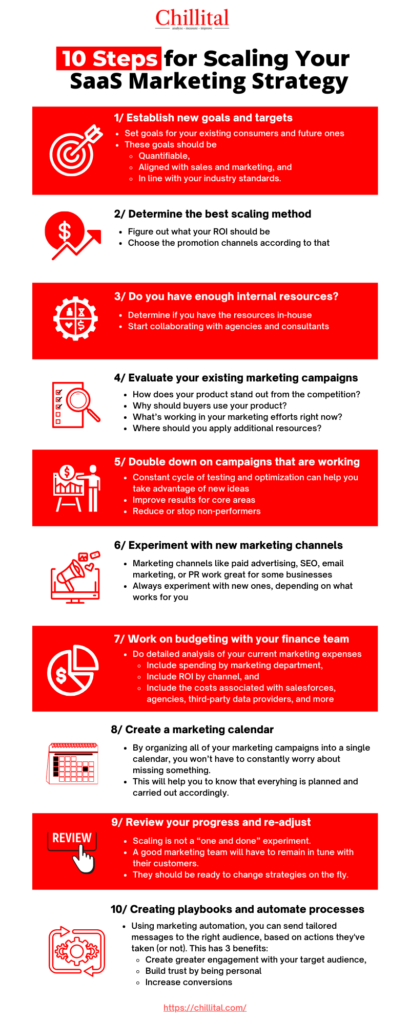
Having a scalable SaaS marketing strategy is about growth with purpose. It’s about taking advantage of opportunities that enable you to expand and grow your business.
But you don’t have to choose between being a small business and an expanding one.
In fact, thanks to marketing technology, the best way to grow your business is by making it more personal and staying true to your brand.
My advice to small businesses is to always start with your team first.
You need to find the right people to work alongside you. Nurture them and place them in roles that challenge them as individuals.
Their growth directly relates to how quickly you can scale. Once you’ve found the perfect team members for your business, consider scaling up by offering new services or additional products.
But remember, don’t go wild adding too many things at once; instead try adding just one new element, test it, and then move on after that initial success.
Here are the 10 steps you should follow if you want to scale your SaaS marketing strategy.
Establish new goals and targets

Your business is undergoing rapid growth but with that comes a new set of issues and problems.
New consumer segments are requiring your business to take on a different set of marketing goals. Your existing consumer segments are also asking for a new set of marketing goals from you.
If you want to grow, you need to establish new goals for your existing consumers and future ones.
Here’s where you use your existing data and financial projections to set achievable goals.
These goals should be quantifiable, aligned with sales and marketing, and in line with your industry standards.
Determine the best scaling method
You’re ready for expansion. You’ve perfected your marketing plan and are now ready to start scaling your business.
You understand the different options for scaling and have determined the best method for you and your business.
So you’ve got some more cash to invest, but where should it go?
Not just any business will benefit from a $5,000 investment.
One method of determining whether an investment is worthwhile is calculating its return on investment. This helps you determine the best methods for scaling your business. These can be increasing your customer base, increasing subscription frequency, or increasing retention.
Do you have enough internal resources for scaling?

It is a near-universal truth that business owners either underestimate the amount of time and resources it takes to properly grow their business or overestimate what those inside the company can accomplish.
Be honest with yourself so you can scale your marketing efforts appropriately.
A lack of a strong in-house marketing team is a common reason that startups fail.
You’ve done all the work to get your product to market, but now you need to build demand for it.
The strategies that generate buzz over time and produce customer loyalty require investment and expertise you don’t necessarily have in-house. You can hire consultants, freelancers, and agencies, but it’s better to have your own marketing team if you can afford it.
However, if you are a growing company with limited marketing resources, it will be difficult to take your marketing campaign to the next level. The solution is to have a marketing agency partner on your team.
Evaluate your existing marketing campaigns
Businesses spend a lot of time and resources on marketing. However, few are able to measure the effectiveness of these activities in a meaningful way.
Taking the time to rethink your approach to marketing can be beneficial for growing your SaaS or driving sales growth.
What’s working in your marketing efforts right now? Where should you apply additional resources?
These are the questions that you need to be asking if you want to scale your current campaigns.
You should be using every touchpoint with your customers. Whether it’s a web page, blog post, email campaign, landing page, or any other communication channel.
Double down on campaigns that are working
As part of managing your inbound marketing activities, it’s important to continuously monitor the success of your campaigns and strategies and make adjustments accordingly.
While not all tweaks are likely to have a significant impact, a constant cycle of testing and optimization can help you take advantage of new ideas, improve results for core areas, reduce or stop non-performers.
For example, if you have been investing in SEO for the past 2 years, and haven’t seen any significant results, consider getting a second opinion on your strategy and focus on the missing pieces. Maybe you haven’t created enough content, or you haven’t generated a lot of buzz in the community.
Experiment with new marketing channels
We often get stuck in a stagnant comfort zone when building our SaaS.
We want to recreate the success we have seen in the past. This is especially true if we’ve had a successful year.
Colloquially, this phenomenon is known as “resting on your laurels”. While there is nothing wrong with being satisfied with your previous success, you should look for new opportunities by experimenting with new channels.
Marketing channels like paid advertising, SEO, email marketing, or PR work great for some businesses.
But other times, these channels aren’t a good fit. With so many sales channels available, you should always keep experimenting with new ones.
It’s important to be open-minded about new sources of customer acquisition — and more importantly — to succeed in finding the most promising new channels for your business. This is where you should also re-evaluate your SaaS positioning and your audience.
Work on budgeting with your finance team

Once your strategy has been validated from a marketing point of view, it’s time to present it to the finance department. They will be the people you’ll be working with on a day-to-day basis.
Finance will understand that marketing is likely looking to acquire the funds necessary to scale up. This could have a direct impact on your company’s bottom line.
The first step in preparing your marketing budget for scaling up involves a detailed analysis of your current marketing spend.
This involves calculating spend by marketing function including ROI by channel. Marketing costs include the costs associated with salesforces, agencies, third-party data providers, and more.
Create a marketing calendar
Regardless of what stage you are in, it is important to start building your projects.
If you’re the type of person who likes to get the best results for your efforts, then it is a good idea to create a marketing calendar for yourself.
By organizing all of your marketing campaigns into a single calendar, you won’t have to constantly worry about missing something. Instead, you will know that everything has been planned out and carried out across multiple platforms.
Review your progress and re-adjust

This can be a tough pill to swallow for many businesses. Marketing requires more planning and resources than you originally thought.
Scaling your SaaS might look like a neat, linear path that scales up over time, but then levels out into the new baseline.
So, at first, marketing costs a little bit with potential benefits that are harder to quantify than after you have more traffic.
But if you put in the work to correctly track and measure your efforts, those marketing investments will pay off and make scaling your business easier.
Scaling is not a “one and done” proposition. A good marketing team will have to remain in tune with their customers. They should be ready to change strategies on the fly.
Focus on creating playbooks and automating your processes
For SaaS, marketing automation is fundamental to creating a scalable, measurable marketing team.
It scales your efforts while giving you more time to focus on other core areas of your business.
Using marketing automation, you can send tailored messages to the right audience, based on actions they’ve taken (or not). This has a three-prong benefit. You create greater engagement with your target audience, build trust with prospects and customers by being personal, and increase conversions from those sources.
Conclusion
Scaling your Saas marketing strategy might seem like an intimidating task. But, if you break it down into a list of actionable items and prioritize the most important ones you’ll find yourself scaling much more easily.
In fact, scaling your SaaS marketing strategy is really just about tracking the right data in the right way and setting up your funnel the right way.
